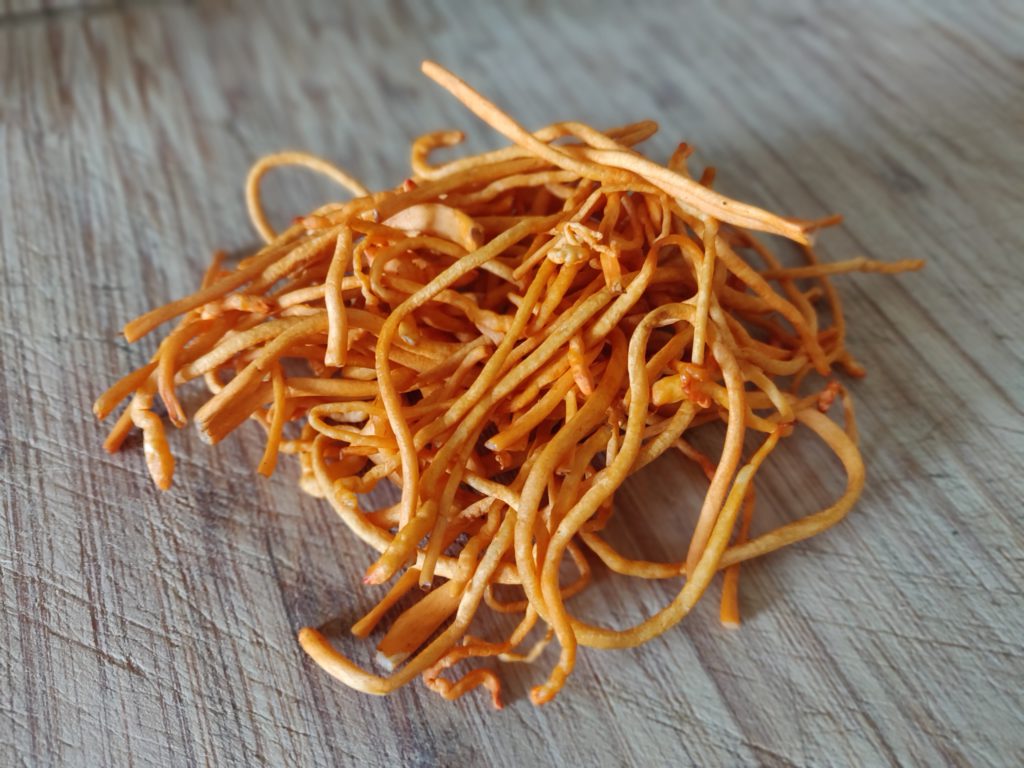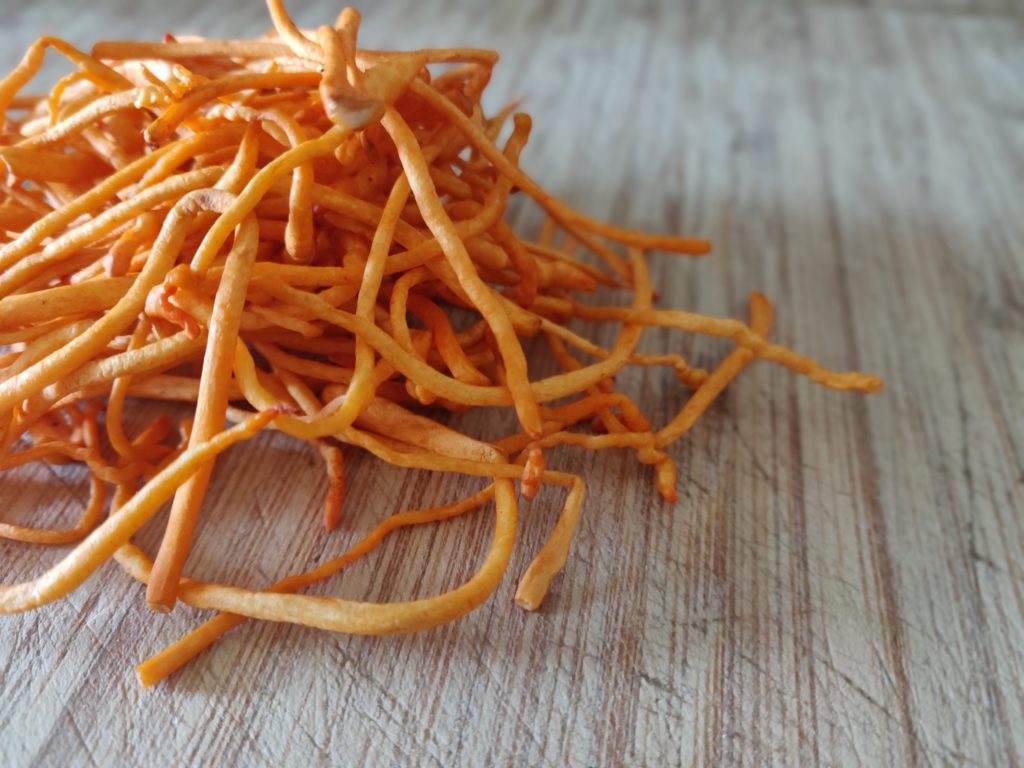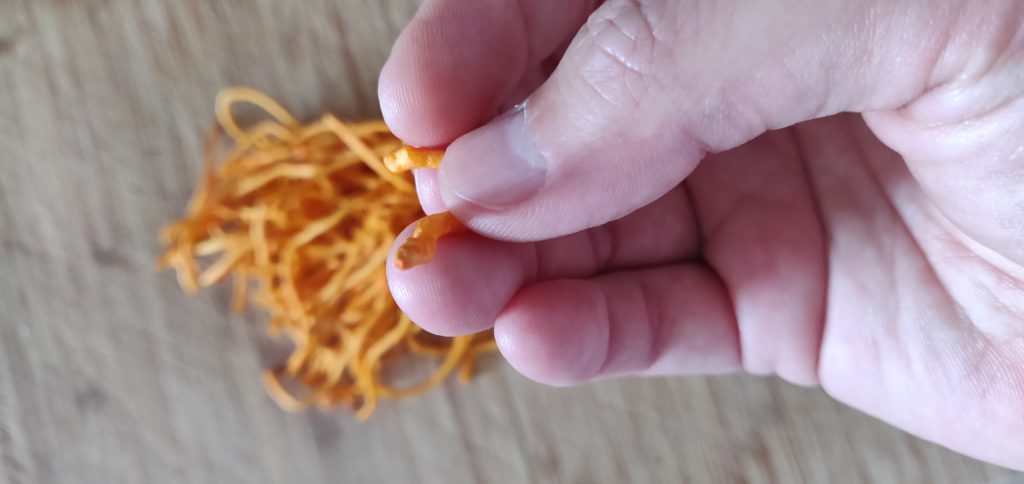- Latin: Cordyceps Militaris
- Chinese: 虫草花
Many of you may have heard of the highly sought after Ophiocordyceps Sinensis. Called “Dong Chong Xia Cao” 冬虫夏草 in Chinese, this elusive parasitical fungus only grows between 3000m and 5000m high on the Himalayan mountains. Shaped like a worm, Ophiocordyceps Sinensis has been known to the Chinese as a miracle herb for more than a millenium.
What is the Ophiocordyceps Sinensis 冬虫夏草?
There are thousands of Cordyceps species around the Northern hemisphere but only one stand out – the Ophiocordyceps Sinensis. Wild Ophiocordyceps Sinensis grows underground on these pure Himalayan soils, by latching themselves onto a worm larvae and then ultimately taking on their shape.
This is the reason for the Chinese name, 冬虫夏草, which means “worm in winter, herb in summer“.

What are the benefits of Ophiocordyceps Sinensis 冬虫夏草?
Anti-fatigue: It boosts athletic performances because of polysaccharides.
Anti-aging: It has a high level of anti-oxidants that fight cell damage by neutralizing free radicals.
Prolong life: Fruit flies and mice had their lifespan prolonged by inhibiting oxidative stress.
Fights tumors: Shown to have anti-tumor effects on lymphoma, melanoma and lung cancer in mice.
Prevents heart diseases: Due to its adenosine content.
Fights inflammation: Contains an immunomodulatory agent by suppressing inflammation.
Male Sexual Health: Increase testosterone levels and sperm production in animals.
You can read about all its benefits here.
What is Cordyceps Militaris then?
The Ophiocordyceps Sinensis could be said to be the most wondrous herb ever discovered by humans.
The only problem, and a very big one, is that it is very rare.
Once Ophiocordyceps Sinensis’s benefits became known, this has sent its price sky-rocketing high. With increased climate change, plus over-harvesting, Himalayan harvesters in Nepal and Tibet are having difficulties finding this elusive fungus.
As a result, Cordyceps Militaris was born. Essentially, Cordyceps Militaris is developed using the spore of the Ophiocordyceps Sinensis, so it is basically the same plant, except there is no worm larvae to host the growing fungus.
The Cordyceps Militaris looks so different from its mother, that it even has a different name.
Of course, the million-dollar question is whether it contains all the wondrous properties.

What are the differences between Cordyceps Militaris and Ophiocordyceps Sinensis?
Cordyceps Militaris is mainly tendrils, called mycelium, which is yellow or orange in colour, because it is grown in a lab. On the other hand, Ophiocordyceps Sinensis has a dark brown root-like structure that produces spores and white tendrils shaped like its worm larvae host.
Because of the differences in composition, Cordyceps Militaris is mainly cordycepin (that is, the fleshy part of a cordycep fungus), while Ophiocordyceps Sinensis is mainly adrenosine. Most of the athletic performance enhancements come from adrenosine. This means Cordyceps Militaris is basically useless in fighting fatigue.
Another difference between the two is the mineral content. Because Cordyceps Militaris is grown in a sterile environment, it lacks the natural minerals that come with a wild Ophiocordyceps Sinensis. Furthermore, the pristine Himalayan soil and conditions are impossible to replicate in a lab. These may have huge impact affecting the effectiveness of the potent cordycepic acid, that is responsible for many of its health benefits.

Lab-grown Cordyceps Militaris can even be poisonous
There is also the risk of Cordyceps Militaris being contaminated.
Cordyceps Militaris can be grown on sawdust, wood chips, compost, straw or grain. It is possible that some of these could be tainted with pesticide. Also, some manufacturers may even add some of these material into the end product, which has led to lead poisoning especially when they have not been well cleaned.
The only way to prevent consuming these material is not to consume Cordyceps Militaris supplement, such as pills or powder. Only buy fresh Cordyceps Militaris or even dried ones.
How do you eat Cordyceps Militaris?
Fresh Cordyceps Militaris can be stir-fried in oil, or eaten fresh in a salad. It is rather tasteless and does not affect the taste of your other ingredients.
The Chinese tend to consume Cordyceps Militaris like how they do Ophiocordyceps Sinensis, i.e. in a soup.
To conclude, Cordyceps Militaris seems to be a more sustainable and affordable alternative to Ophiocordyceps Sinensis, unless you are filthy rich. But you have to be realistic about what you can get out of Cordyceps Militaris, because it may not be as effective as its wild ancestor. Furthermore, you have to be careful about contamination by consuming only fresh or dried whole Cordyceps Militaris, not in supplement form.


1 Comment